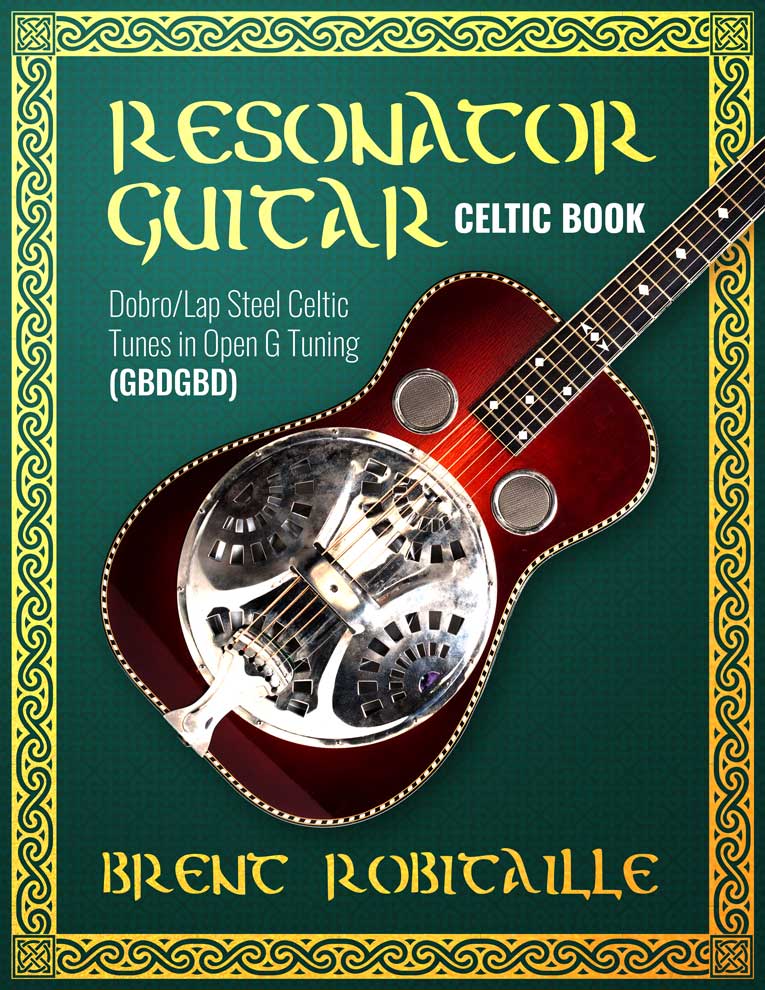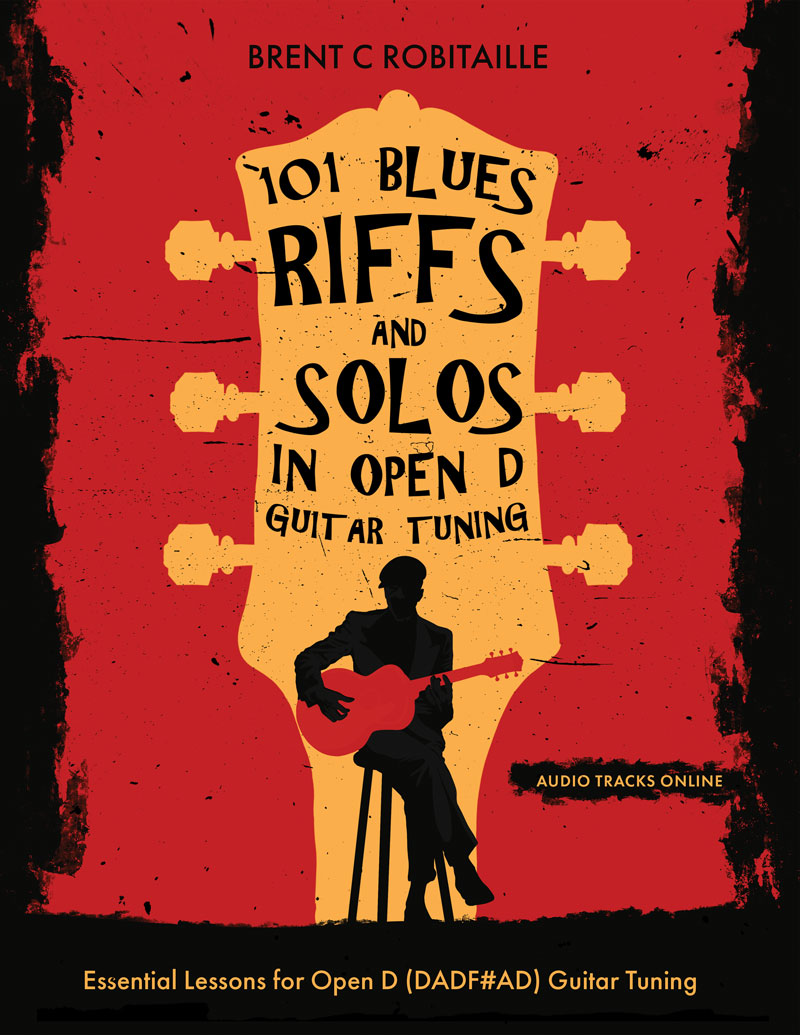Unlocking the World of Resonator (Dobro) and Lap Steel Guitar Playing
Whether you’re drawn to the soulful sounds of delta blues, traditional blues, bluegrass, or even jazz and country, the resonator guitar (also known as a “dobro”) holds a unique place in the world of acoustic instruments. Its signature sound is characterised by a built-in resonator cone that amplifies vibrations from the strings, creating a bright and powerful tone.
In this post, we’ll explore essential tips for mastering the resonator guitar and lap steel. It doesn’t matter which tuning you prefer, GBDGBD or DADF#AD, the technique is the same. So, grab your slide and let’s dive in!
Resonator Tip #1 – Grips
If you wear two fingerpicks and one thumbpick there are ten possible ways to pluck the strings using your index, middle and thumb. There are ten possible “grips” to play six strings with three fingers. Though some grips are more common and practical, I suggest you practice all ten grips regularly.
Here are the ten grips to work on in Open G tuning, starting with plucking the three notes together and then separately like an arpeggio:
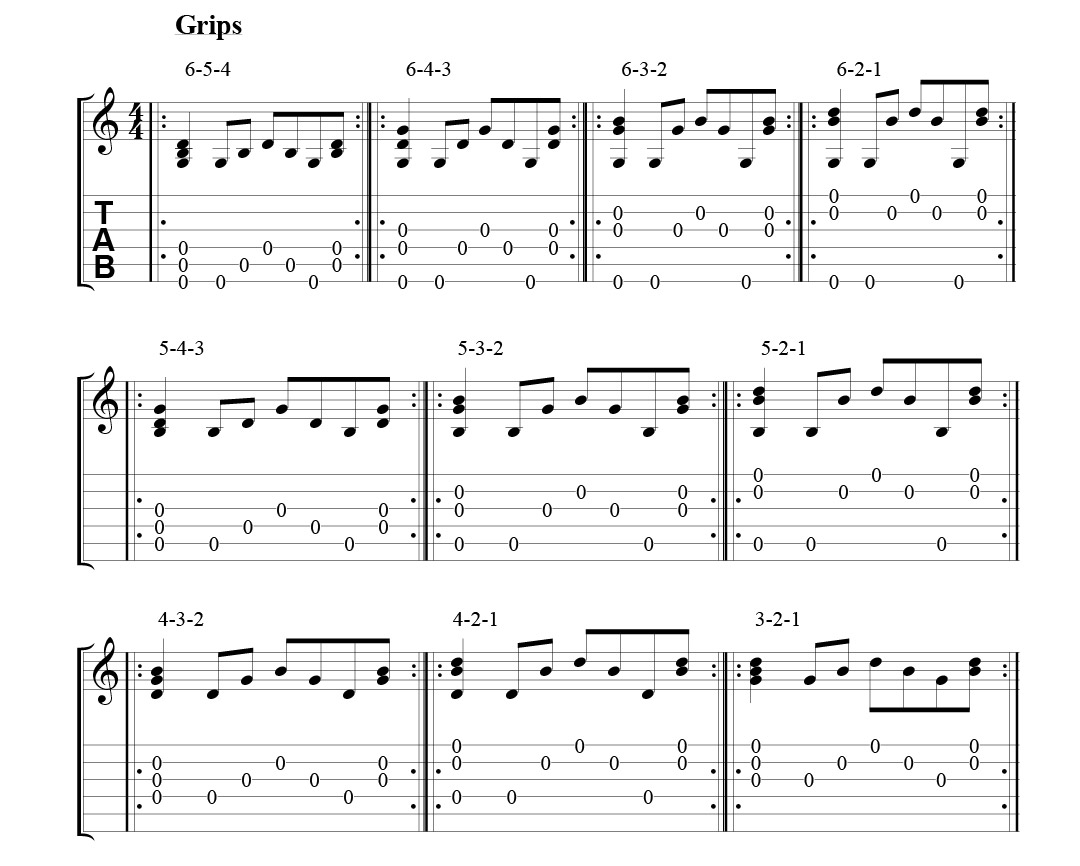
Now that you have a handle on the grips let’s go on to the most important technique to master on the resonator – muting.
Resonator Tip #2 – Right-Hand Muting
Like most slide playing, understanding the importance of muting the strings is essential and your first technique to practice. Let’s start with right-hand muting.
There are several ways to mute the resonator, but the most common is right-hand picking finger or thumb muting. To do this muting, you simply place your finger or thumb on the vibrating string. For example, after you play a note, put the finger back down to stop it from ringing. You can also do this with the thumb directly or on the side.
Try the scale exercise below with the thumb, index or middle finger. Pluck the string and then mute the string with the same finger. There should be no sound, as indicated by the rest in the notation line above. The arrow shows what strings to mute with the right hand.

The next few exercises are a little more tricky but essential to work on. Use the side of the thumb and a combination of fingers to mute the strings when silencing a chord or arpeggio; Remember, the arrow shows where the muting occcurs.


I suggest you incorporate muting exercises into your regular practice routine. Check out my Resonator Guitar Celtic Book for more exercises and techniques.
Resonator Tip #3 – Left-Hand Muting
Using the left hand to mute is not as apparent as right-hand muting, but it is still an excellent technique to master. In this case, use your left-hand thumb or a combination of available fingers to stop the strings from ringing:

Always look for ways to clean up your playing and find examples from your repertoire to practice.
Resonator Tip #4 –Hammer-Ons and Pull-Offs
Hammer-ons and pull-offs are another quintessential technique on the resonator. They are often a good choice to simplify complex movements with the tone bar. Hammer-ons and pull-offs can only be done with an open string and work well in scale passages on faster tunes.
Try out the following series of exercises to help develop your H-O and P-O techniques:
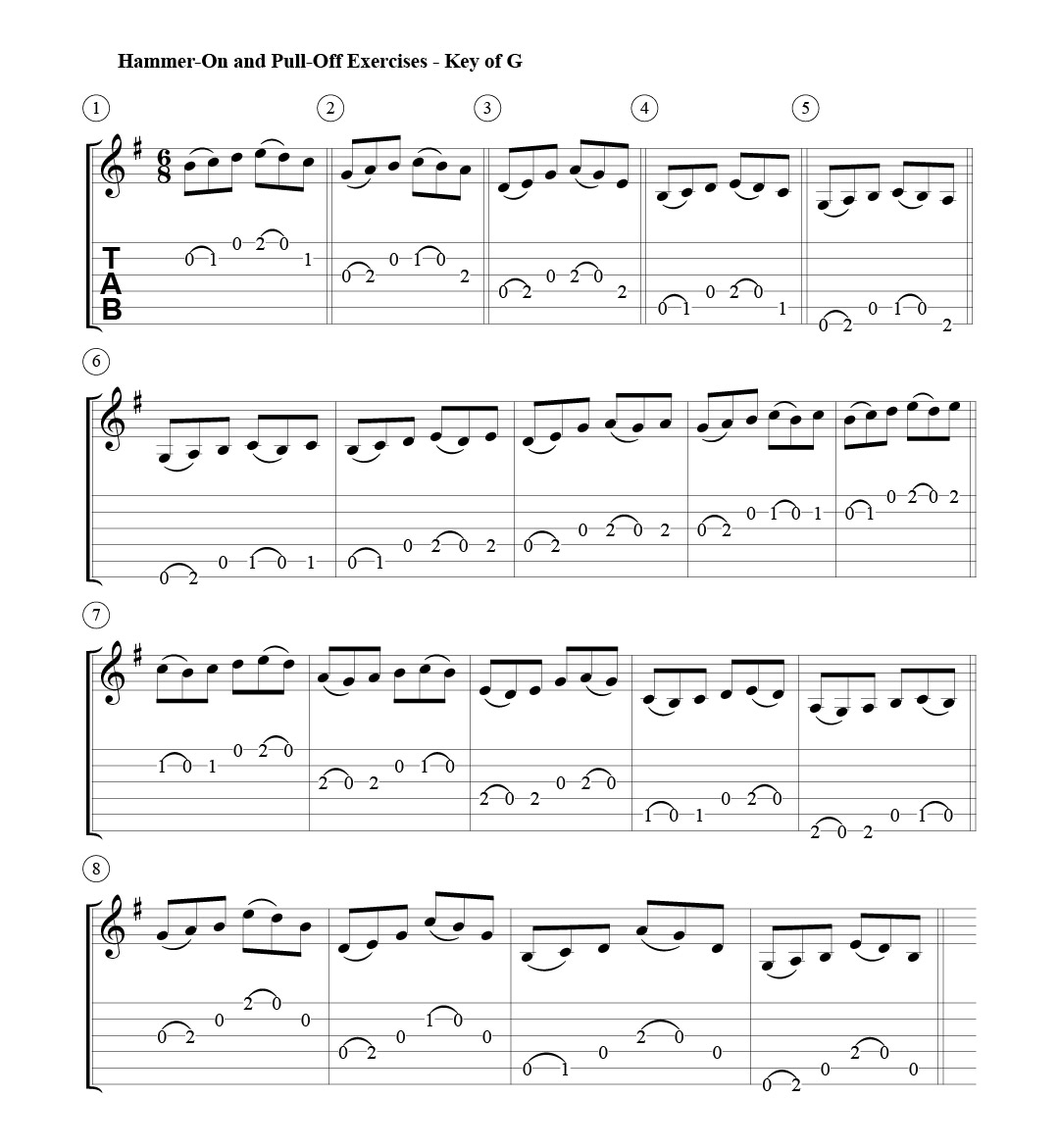
Resonator Tip #5– G and D Position
It is essential to learn the G and D in the open and seventh positions and produce riffs and tunes based on the major, pentatonic, and blues scales. These positions allow you to use your hammer-ons and pull-offs very effectively with the open strings. I suggest you memorize these scales forwards, backwards and sideways!
A good place to start is with the pentatonic major and minor scales in G and D in open positions. After you have this in your bar, move on to the major and minor pentatonic and blues scales. And, of course, if you have a capo, you can play in any key— just make sure to practice with the capo before the gig. ![]()

Resonator Tip #6 – Slides and Bar Technique
Slides are the meat and potatoes that define the characteristics of resonator playing.
Slides are similar to hammer-ons and pull-offs, but unlike the guitar, we only have a bar, so we replace them with slides. Slides are highly expressive and excellent for achieving a singing-like quality, especially when combined with vibrato.
Vary the speed of your slides for different effects, and remember to use muting techniques. Slides are great, but it’s usually a good idea to have a variety of slides and non-slide notes. There is no right or wrong; it is just taste, but too much salt can ruin a good dish.
For more slide tips, see my post, 6 Essential Skills on How to Play Slide Guitar Like a Pro.
Resonator Tip #7– Vibrato
Understanding the nuances of vibrato techniques is essential for guitarists, as different styles offer varying degrees of expressiveness and suitability based on factors like fret position and tempo. The primary considerations with vibrato are the speed and width. Each will have a time and place.
First, narrow vs. wide vibrato speeds. The tempo of the tune often reflects how fast you move the bar. A quick tune may be best with a fast vibrato, and a slow tune may be best with a slower vibrato. There is no right or wrong here; use your ear, but don’t overdo it—too much vibrato gets old quickly.
Second, the width, or how far in and out of tune you are. Usually, you want to play right over the fret to keep in tune, but that is not always the case, especially when playing blues and rock. This out-of-tune playing is probably the sweetest part about playing with a slide-you get to choose.
Resonator Tip #8 – Ornamentation
You are likely adding ornaments to your playing and didn’t realise it. Ornamentation is when you embellish a melody or riff by adding grace notes, trills, turns, or other expressive elements. Ornaments can add life and, of course, variation to any tune.
I see ornamentation as a type of improvisation that adds spice to your playing. Listen to any of the great players, and you will hear all kinds of ornaments that, when removed, would take away much of the expressiveness.
I suggest learning a tune or riff in its bare-bones form before adding ornamentation. Eventually, you will find something you like that fits that tune, but always keep an ear to experimenting. Here are a few of the main ornaments with examples below:
- The Cut is a quick pull-off or slide from a higher to a lower note, usually by a tone or a semi-tone above.
- The Tap is a quick hammer-on or slide played from a lower to a higher note, usually by a tone or a semi-tone below.
- The Casadh or Pat is like a trill that consists of hammering on and pulling off above a note and playing legato with one pick stroke.
- The Short or Half Roll is played legato with one pick stroke starting above the main note. There are 3 parts: 1) pull off or slide from a higher note to the main note, 2) pull off or slide from the main note to a lower note, 3) hammer on or slide from a lower note back to the main note.

Want to learn 36 major chords in Open D guitar tuning? Check out the Open D Guitar Chords Major Lesson.
Resonator Tip #9 – Playing in Tune
Nobody plays perfectly in tune, so let’s start with a fair understanding. As mentioned earlier, perhaps the best part of resonator playing is playing slightly out of tune.
Hopefully, by now, you understand how to play directly over the fret to be in tune, though there is more to it than that. When you slide into a note, you must use your ear to determine where to stop!
The angled visual perspective from the player’s vantage point does not show the actual slide position as directly over the fret. Visual adjustments must be made depending on where you are on the fretboard. For example, when you look down, your perspective of a note in tune on the fifth fret does not look like the slide is directly over the fifth fret. Therefore, the only accurate way to play in tune is by ear.
To play in tune, you should start by getting your instrument tempered to the correct pitch. For example, this means you might have to tune your B string (3rd in the chord) slightly flat. Using harmonics gives you a better indication that your guitar is in tune. Listen for the “beats” and use your ear so the overtones vibrate sympathetically. Also, test the major chord on different frets to verify.
Your instrument’s intonation also depends on the type of bridge you have. Some bridges are adjustable on lap steels but are more tricky with the resonator. If you can’t seem to get in tune, the best advice is to bring your instrument to a qualified repair person to set it up or try one of the electronic tuners that show how to “sweeten” the notes. I use the Peterson tuner when recording, but ideally, the best is to use your ear.
Resonator Tip #10 – Campanella
One of the benefits of using an open chord tuning, like open G or D, is the ability to use open strings along with fretted notes. A typical approach is to let the notes overlap to produce a harp-like ringing sound.
This overlapping will create a drone sound but also helps with a smooth transition between notes, similar to a piano with the pedal down. This technique has several names: cascading, harp-scales, or Campanella.
The best way to develop this technique is to practice scales going up and down the neck. Hold the bar down where the * is indicated in the scales below and let the open strings overlap the fretted notes. Here are a few major and minor scales to get started with:
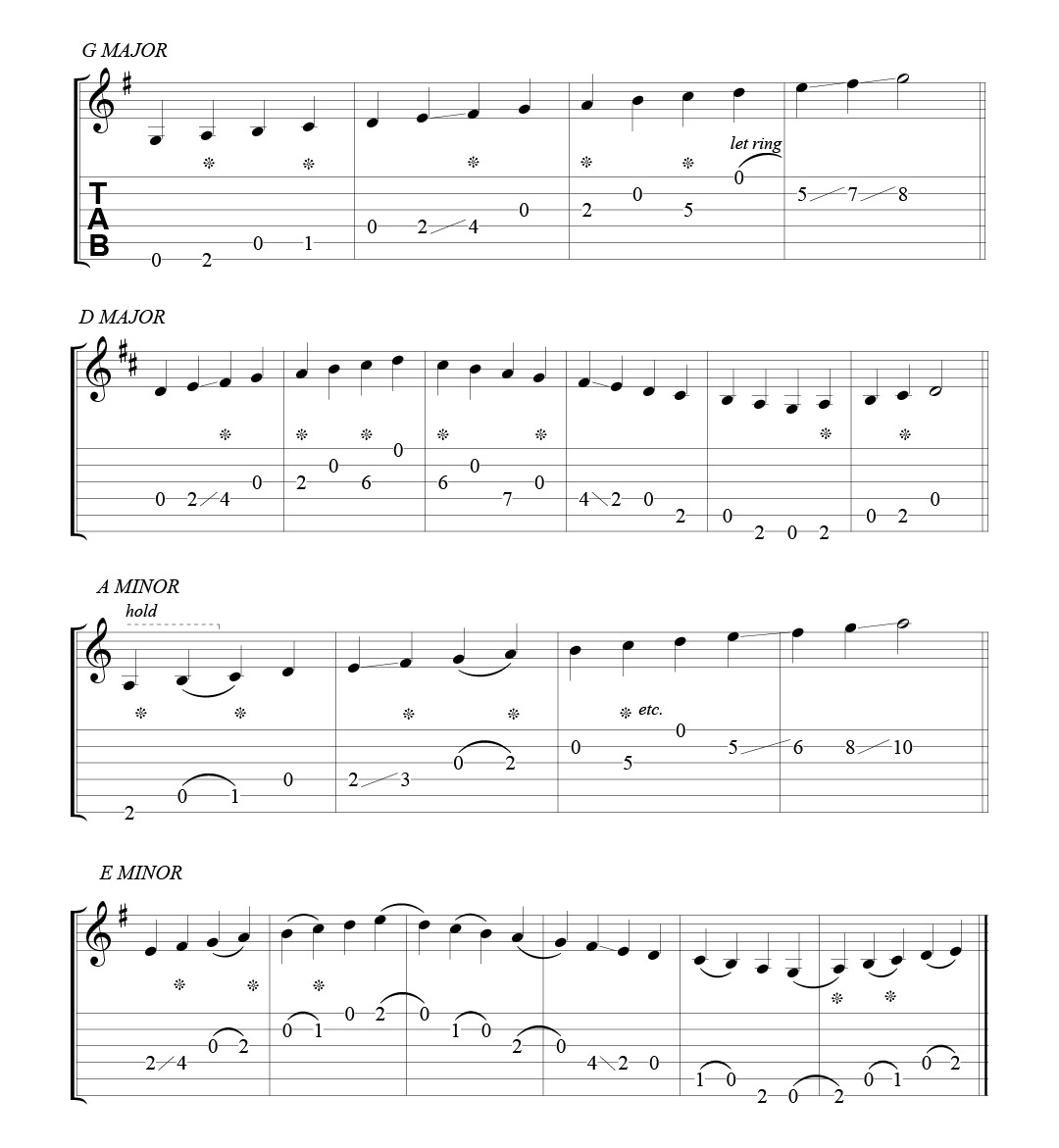
Are you stuck and need some help getting better?
Resonator Tip #11 – Muscle Memory and Hand Movements
- Hand Movement – Use open strings to shift your hand position from a higher to lower or lower to higher note. In other words, if you are playing a fretted note down the neck and quickly moving up the neck, use an open string to transition from one position to another. See the major and minor scales above for examples.
- Muscle Memory—Always start slowly before you begin as you learn new tunes. Work out the bar positions and chords, then gradually increase the tempo. Practice with a metronome and use accompaniment software or backing tracks to drill the tune repeatedly until it is memorised. If no tablature is available for more complicated tunes, you can write down the fret numbers and any special right-hand fingerings or techniques. You will likely need to memorise the hand movements for more challenging pieces and riffs until they are firmly in muscle memory.
Resonator Tip #12 – Find the Right Equipment
- Picks—Experiment with different pick sizes and fingerpicks. I’ve tried many different thumb picks and fingerpicks before settling on the Dunlop medium thumb pick and the National N4 fingerpicks. That being said, I sometimes play without fingerpicks on slower tunes to lessen the clicking sound of the picks, especially when recording.
- Bars—Like the picks you choose, the bar will present the same challenge. Unfortunately, sometimes you must try every bar out there before you realise the first one you bought is the best. I’ve been using the Lap Dawg and the GS-1 bar and switching between the two.
- Capos – Not every tune will be in G and D, so getting a capo is not a bad idea. If you learn the G and D positions, you can play in every key with the capo.
One last tip…
There’s listening to music and active listening. Listen to how accomplished players phrase and ornament the melody, dynamics, tone, tempos, etc. Can you write a resonator post without mentioning Gerry Douglas, Rob Ickes, Mike Auldridge, Johnny Bellar, Bob Brozman, Cindy Cashdollar, Stacy Phillips, etc.
Also, it’s a good idea to record and listen to your tone and tuning. It’s incredible what you thought you heard and what you actually did. It can go both ways; sometimes, you think it sucked when you were fine!
Check back again for more resonator guitar lessons, books and sheet music.
Resonator Guitar Celtic Book
The Resonator Guitar Celtic Book
40 tunes arranged for Resonator Guitar (Dobro-LapSteel) in Open G (GBDGBD) to sink your tone bar into. A good selection of the most popular session tunes, including jigs, reels, hornpipes, waltzes, slip-jigs, and polkas. There are also some excellent exercises to perfect your muting, slide and intonation techniques, major, minor, and modal scales, arpeggios, and valuable tips for playing Celtic music. Audio tracks below. 120 pages.
Resonator Guitar Dobro Chords, Scales and Fretboard Poster Set (GBDGBD)
- Elegant resonator dobro guitar chord and fretboard poster set tuned GBDGBD.
- Two posters included showing chords, fretboards, scales and arpeggio in Open G.
- Convenient size poster 12” x 18” (x2). Side by side, the two posters are 24” x 18”
- All posters have a gloss finish printed on 100# Digital Gloss Text.
101 Blues Riffs and Solos in Open D Guitar Tuning
Take your Open D guitar playing to the next level with “101 Blues Riffs & Solos in Open D Guitar Tuning.” The most complete instructional book ever written exclusively in DADF#AD tuning. Using a combination of slide, fingerstyle and pick playing, you will cover all the bases needed to develop a solid technique in open D guitar. Everything you need to master the blues with essential lessons in DADF#AD guitar tuning!
• Master the Blues in Open D Guitar Tuning
• Slide, Fingerstyle and Picking Riff and Solos
• Traditional, Delta, Rock, Funk and Jazz Blues
• Extensive Scale, Chord, and Arpeggio Charts
• A Complete Course for Open D (DADF#AD)
• Audio Tracks Below

